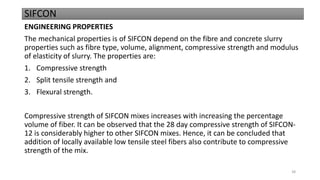Sifcon223.pdf
- 1. SIFCON 32
- 2. SIFCON Slurry Infiltrated Fibre Concrete (SIFCON) is unique construction material possessing high strength as well as large ductility and far excellent potential for structural applications when accidental or abnormal loads are encountered during service. • SIFCON exhibit new behavioral phenomenon, known as “Fiber-lock” which believed to be responsible for its outstanding stress-strain properties. The matrix of SIFCON has no coarse aggregates, but high cementitious content. However, it may contain fine (or) coarse sand and additives such as fly ash, micro silica and latex emulsions. • The unit weight of SIFCON is typically higher than concrete and normal FRC because of the relatively heavy weight of the high fiber content. The unit weight increase is almost linearly proportional to the fiber content. 33
- 3. SIFCON Factors Affecting SIFCON Efficiency The following factors affect the strength of SIFCON and the ultimate strength, ductility and energy absorption are all affected by fiber alignment. i. Slurry strength ii. Fiber volume iii. Fiber alignment iv. Fiber type Advantages of SIFCON i. SIFCON possess excellent durability, energy absorption capacity, impact and abrasion resistance and toughness. ii. Modulus of elasticity (E) values for SIFCON specimens is more compared with plain concrete. iii. SIFCON exhibits high ductility. 34
- 4. SIFCON iv. The limitation in SFRC that is balling problem of steel fibers with increase in fiber volume is overcomes by SIFCON, because of its fiber alignment. v. Deflection for SIFCON will be very less compared to conventional and will act as rigid body. DISADVANTAGES OF SIFCON Inspite of unique properties of SIFCON it doesn’t have much limitations. Uniformity and quality control of fiber distribution in addition to high placement cost associated with manual addition of fibers, restricted wide applications of these composites. 35
- 5. SIFCON MATERIALS USED or CONSTITUENT MATERIALS SIFCON constitutes several materials like, cement, sand, fly ash, steel fiber, high range water reducing admixture called CONPLAST SP- 430. MIX PROPORTION In general, proportions of cement and sand generally used for making SIFCON are 1:1, Fly ash equal to 50%by weight of cement is used in mix. w/c is 0.45 and super plasticizers varies from 2% to 5% of weight of cement can be used. The percentage of fibers by volume can be where from 6% to 12% used. Sand which passes through 600 μ and retains 300 μ can be selected. The process of making SIFCON is different, because of high steel fiber content. While in SFRC the steel fibers are mixed intimately with wet (or) dry mix of concrete, prior to mix being poured into forms. SIFCON is made by infiltrating low viscosity cement slurry in to a bed of steel fibers “pre packed” in forms (or) moulds. 36
- 6. SIFCON USAGE /APPLICATION AREA SIFCON has properties like ductility, crack resistance, penetration and impact resistance very high compared to other materials like SFRC, concrete it is best suited to applications in following areas:- • Pavement rehabilitation and pre cast concrete products. • Overlays, bridge decks and protective revetments. • Seismic and explosive resistant structures. • Security concrete applications.(safety vaults, strong rooms) • Refractory applications. (soak-pit covers, furnace lintels, saddle piers ) • Sea protective works. • Military applications such as anti-missile hangers, under ground shelters. • Aerospace launching platforms. • Repair, rehabilitation and strengthening of structures. • Concrete mega structures like offshore and long span structures, solar towers. 37
- 7. SIFCON ENGINEERING PROPERTIES The mechanical properties is of SIFCON depend on the fibre and concrete slurry properties such as fibre type, volume, alignment, compressive strength and modulus of elasticity of slurry. The properties are: 1. Compressive strength 2. Split tensile strength and 3. Flexural strength. Compressive strength of SIFCON mixes increases with increasing the percentage volume of fiber. It can be observed that the 28 day compressive strength of SIFCON- 12 is considerably higher to other SIFCON mixes. Hence, it can be concluded that addition of locally available low tensile steel fibers also contribute to compressive strength of the mix. 38
- 8. SIFCON ENGINEERING PROPERTIES (contd….) • The tensile strength of SIFCON is higher than M30 grade concrete. It was observed, there is an increase in the compression, tension and flexural strength with an increase in the volume of steel fibers fraction. 12% addition of steel fibers increases the strength about 36.2% when compared to conventional concrete. • Flexural strength of SIFCON is 5.5 N/mm2 for using 12% volume fraction of Steel fiber. If using 14 % of steel fiber this value also increasing 39
- 9. POLYMER CONCRETE POLYMER CONCRETE (PC) • It is the latest technique which involves impregnation of monomer and subsequent polymerization to reduce the inherent porosity of the concrete and improve the strength and other properties of concrete. • The main technique in producing PC is to minimize void volume in the aggregate mass so as to reduce the quantity of polymer needed for binding the aggregates. This is achieved by properly grading and mixing the aggregates to attain the maximum density and minimum void volume. • Purpose of developing PC/ Advantages of PC are to minimize voids and increase the resistance to chemical attack. • The strength obtained by PC can be as high as 140 Mpa with a short curing period. 40
- 10. POLYMER CONCRETE POLYMER CONCRETE (PC) (contd….) Types of polymer concrete i. Polymer Impregnated Concrete (PIC) ii. Polymer Cement Concrete (PCC) iii. Partially Impregnated and surface coated polymer concrete. Polymer Cement Concrete: It is made by mixing cement, aggregates, water and monomer. Such plastic mixture is cast in moulds, cured, dried and polymerised. The monomers that are used in PCC are: i. Polyster-styrene ii. Epoxy-styrene iii. Furans iv. Vinylidene Chloride 41
- 11. SIFCON QUESTIONS 1. Define SIFCON. Mention the materials used. 2. What are the factors affecting the efficiency of SIFCON? 3. Mention applications of SIFCON. 4. What are the advantages and disadvantages of SIFCON? 5. List the properties of SIFCON. 6. Enumerate mix proportions for SIFCON 42










